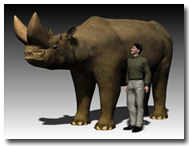 |
 'Impacting Global Climate' 'Impacting Global Climate'
|
 |
Top
Scientists Conclude Human Activity Is Affecting Global Climate
Two of the nation's best-known atmospheric scientists,
after reviewing extensive research by their colleagues, say there
is no doubt human activities are having measurable-and increasing-impacts
on global climate. Results of the study, which appear in the December
5th issue of the journal Science as part of a "State of the Planet" assessment,
cite atmospheric observations and multiple computer models to paint
a detailed picture of the climate changes likely to buffet Earth
in coming decades, including rising temperatures and an increase
in extreme weather events such as flooding. Thomas Karl of NOAA's
National Climatic Data Center in Asheville, N.C., and Kevin Trenberth,
director of the Climate Analysis Section at the National Center
for Atmospheric Research (NCAR) in Boulder, Colo., conclude that
industrial emissions have been the dominant influence behind climate
change for the past 50 years, overwhelming natural forces.
More... (posted
December 4, 2003) |
 |
|
 |
| Image: An example of the genus Arsinoitherium,
a large mammal of the Oligocene epoch (approximately 24-34
million years ago), with an average-sized modern man shown
for scale. Caption: A new species of Arsinoitherium found in
the Chilga region of Ethiopia is both the largest (probably
standing ~7 feet at the shoulder) and the youngest (approximately
27 million years old) yet discovered. An average-sized modern
man is shown for scale. Credit: Trent Schindler / National
Science Foundation |
New
Fossils from Ethiopia Open a Window on Africa's "Missing Years"
An international team of researchers has announced
the discovery of new fossils from the highlands of Ethiopia. The
fossils fill a long-standing gap in scientists' understanding of
the evolution of African mammals. The results are reported in this
week’s issue of the journal Nature. "The work of this team continues
to reveal the extremely rich fossil record encased in East Africa’s
rocks," says Rich Lane, program director in NSF's division of earth
sciences, which funded the research. "It also sheds light on the
role pre-modern animals played in establishing the worldwide distribution
of mammals today." The dynamics of animal populations from 24 million
to 32 million years ago has long stood as one of the most poorly
known for all of Africa and Arabian, says John Kappelman, a paleontologist
at the University of Texas and the project's leader.
More... (posted
December 4, 2003)
|
 |
|
Taking
Cues from Mother Nature to Foil Cyber Attacks
Taking their cues from Mother Nature and biodiversity,
computer scientists at Carnegie Mellon University and the University
of New Mexico are collaborating on a National Science Foundation-supported
project to study "cyber-diversity" for computer systems as a way
to fend off malicious viruses, worms and other cyber attacks. In
nature, diseases are most devastating when an infection-causing
organism encounters a "monoculture," a vast swath of genetically
similar individuals, each susceptible to the organism's method
of attack. In the same vein, computer viruses and worms exploit
the same flaw on every computer running the same software. "We
are looking at computers the way a physician would look at genetically
related patients, each susceptible to the same disorder," said
Mike Reiter, a professor of electrical and computer engineering
and computer science at Carnegie Mellon and associate director
of CyLab, a Carnegie Mellon initiative focused on advancing cybersecurity
technology and education. "In a more diverse population, one member
may fall victim to a pathogen or disorder, while another might
not have the same vulnerability."
More... (posted
December 4, 2003) |
 |
|
Now Available:
FY2004 Guide to Programs
The new edition of the
Guide to Programs is available on the web at http://www.nsf.gov/cgi-bin/getpub?gp.
Published each fiscal year, the Guide is a compilation of funding opportunities
offered by NSF for research and education in science, mathematics, engineering,
and technology. The Guide includes broad, general descriptions of programs
and activities for each NSF directorate. It also offers links to other information
sources, including NSF directorate home pages; to related publications such
as program announcements and solicitations that contain additional proposal
or eligibility information; and to the E-Bulletin for deadline and target date
information. NSF funds research and education in most fields of science and
engineering, and it accounts for about one-fourth of all Federal support to
academic institutions for basic research.
(posted December 4, 2003)
View the FY
2004 Guide |
 |
| |


|

